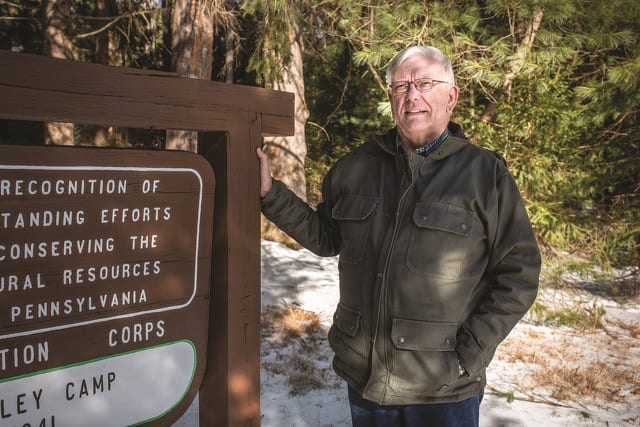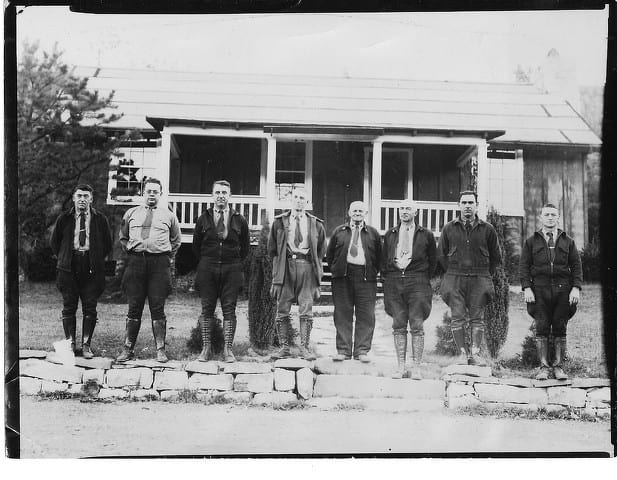When Bill Marcum was growing up in Coburn, he spent a lot of time with his grandfather. Sumner Frankenberger, or “Sum” as he was known, was a sociable man, well known throughout the region.
“Everywhere we went, people would call out to him,” Marcum says.
When Marcum was a teen, his grandfather would do what it took to keep him and his brother out of trouble.
“He would volunteer us to help farmers in hay season or when an extra hand was needed,” he says. “One time he had me paint his house – not that it needed it, but it sure kept me busy.”
Sum was a man who wore many hats. In addition to building and operating the Farmer’s Supply Company in Millheim, he had owned a saw mill, a threshing business, sharpened rotary mower blades, and served on the town council.
But of all the jobs Sum held and the things he did, nothing meant more to him than his time as a foreman in the Civilian Conservation Corps Camp in Poe Valley; he worked with the CCC from the program’s beginning as the Emergency Conservation Work Company in 1933, until 1939.
“He would talk about it to anyone,” Marcum says. “If you gave him a minute, he’d give you an hour.”
Because he grew up hearing so many stories about his grandfather’s time in the CCC, Marcum didn’t give them a lot of thought until after Sum passed away. In cleaning out the house, his mother came across a box of memorabilia his grandfather had collected from his CCC days.
“Anything CCC-related, he kept it,” Marcum says. “Camp logs, blueprints, meal receipts, camp minutes, safety inspection reports … all kinds of textural documents.”
It intrigued Marcum, who began to delve into the documents. Wanting to know more, he decided to host a reunion at the camp in the early 1980s for anyone who had been part of it. Finding interested participants was easier than he’d anticipated.
“There was a publication called Grit, and I asked if they’d run a story,” he says. “Crazily enough, the Sunday it ran my phone began ringing at 6:30 in the morning and didn’t stop.”
Calls came from across the country and reunions became a regular event for the next 15 years, drawing 150 participants. Reunions included speakers, stories, and even meals drawn directly from camp menus.
Through the years, Marcum, with the help of his wife, Mary, and mother, continued to collect documents and memorabilia related to the Poe Valley camp, which had been home to 200 men.
“My wife suggested I write a book,” Marcum says. “I’m not an aspiring writer, but one day I said, ‘Why not?’ Then I found out I had to learn to type, and that was a trick.”
Marcum’s book, The Foreman’s Boys: The Story of Civilian Conservation Corps Company 1333, Camp S-63, Poe Valley, is an exhaustive recounting of daily life in the camp. Like his grandfather, Marcum has amassed a treasure trove of documentation and information about the camp years and its achievements. Everything from lists of enrollees, to schedules of reports required by military commanders, to meal receipts (two meals for 87 cents!), to daily estimates of labor hours and expenses for every job performed in camp are here.
“Today if you go to the library you will find many books about the program, because people are starting to want to know about it,” Marcum says. “But the books are kind of generic. I wanted to tell the story of what happened in one camp from beginning to end.”

Bill Marcum at Poe Valley. Photo by Darren Andrew Weimert
Desperate times
The program, which was part of Franklin D. Roosevelt’s New Deal, was designed to provide jobs for young men and help relieve families during the Great Depression in addition to helping with the conservation and development of natural resources.
Many young men had been forced to leave school to look for work to try to help their families survive, but work was scarce and many left home to relieve the burden on those at home. With astronomical rates of unemployment, many fell on desperate times.
Since the Army had been given the task of mobilizing and establishing the campsites, enrollees were sent to military facilities that served as induction centers. There, young men who had been starving on the streets were given three hearty meals a day, physical and dental exams, surplus Army clothing and footwear, strength training, and learned the general Army way of orderly living. For many, it was the first time they’d eaten regularly or had more than one pair of pants or decent shoes in months.
“The average enrollee gained an average of 18 pounds,” says Paul Fagley, environmental education specialist with the Pennsylvania Department of Conservation and Natural Resources.
Enrollees were male, 18-25 years old, and from a family on local relief. Once accepted into the program, they were required to serve a minimum of a six-month period with an option to serve as many as four periods if outside employment couldn’t be found.
The work was back-breaking manual labor for which they were paid $30 a month, $25 of which had to be sent home.
“They were paid a dollar a day, which wasn’t a bad wage in that day,” Fagley says.
“I’m now able to appreciate the desperation that would lead them to join camps for a dollar a day,” Marcum says. “I learned that money helped keep families together – it literally put food on the table and coal in the bin.”
The Army, which had overseen the setting up of the camps, was in charge of daily life there. On the job, program foremen and supervisors oversaw and were responsible for the men.
There was more to life than just work, however. Education programs were set up, initially to help those who had dropped out of school earn a high school diploma. Programs were expanded to include a variety of trades, training that provided many enrollees with a vocation that lasted a lifetime. Weekends meant free time and the boys would pile into the only truck available for the chance to visit town, see a movie, and maybe even meet a girl.

Photo courtesy of Bill Marcum
A dam and a lake
The work, however, was never-ending. Camp had to be built from the ground up. Forests that had been left untouched needed roads, trails, and fire roads, undergrowth needed to be cleared. Trees needed to be planted to reforest where logging had cleared the land.
The few existing roads were little more than rutted paths, and in the early days, there was only one truck in camp and almost no heavy equipment. Men would walk several miles to the job site, work all day, then walk back to camp.
“They were building roads with pick and shovel, moving rock by hand,” Marcum says, adding that dynamite was often used as well. “The basic safety protocol was [to] get behind something and keep your head down.”
Days began at 6 a.m., with light exercise at 6:30, followed by breakfast. Work began at 8 and ended at 5 when men came back, cleaned up, and dressed in uniform for dinner.
The biggest project, of which Marcum’s grandfather was foreman, was the construction of the dam at Poe Valley and the creation of the lake.
“If you think about it, in Pennsylvania, for most parks the focal point is a lake,” Fagley says.
Located two miles east of the camp, the dam was built on Little Poe Creek. Construction, which began in October 1935, was plagued by delays. Bad weather, flooding, failing and broken equipment, and planning revisions all held up progress. Plans for the spillway, originally slated for the south end of the dam, were revised to place it at the north end. The dam opened on December 19, 1937. The dam and resulting lake serve as a calling card for the popular Poe Valley State Park.
The program ran until 1942, with the advent of a better economy and the onset of World War II. While exact numbers aren’t available, it’s known that a great many enrollees signed up to fight in the war.
Today, Marcum says, he sees a renewed interest in the CCC and its accomplishments.
“We’re becoming people that are interested in things that are green, how they came to be, and how to keep our state and national parks green,” he says. “Going to state parks has become a big interest and when they go, people see these old things and want to know more about how they came to be there.”
As a former forester, John Eastlake came to know the CCC works well.
“Almost every day I see their projects, trails and roads, trees they planted,” he says.
Meeting some of the men at one of the reunions gave him a new appreciation and respect for them, he says.
“They were really fascinating,” he adds. “They had an attitude that they could do just about anything, get along with anyone, and were in really great shape due to the work they’d done. That’s why they won the war for us.”
Legacy Day of the Civilian Conservation Corps will be held Sunday, August 9, from 10 a.m. to 3 p.m. at Poe Valley State Park. In conjunction with the Centre County Historical Society, Bill and Mary Marcum will present an informational program and a free lunch featuring items from a CCC menu. For more information, call (814) 234-4779, or visit the Centre County Historical Society website at centrehistory.org/legacyday.
The Foreman’s Boys: The Story of Civilian Conservation Corps, Company 1333, Camp S-63, Poe Valley, is available at Barnes & Noble, Amazon, williamlmarcum.com, and sunburypressstore.com.
Robin Crawford is a freelance writer in State College.



